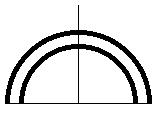Here's the extra info you requested!
As we gaze at the stars, our eyes automatically follow them across the sky as the Earth turns. A telescope must have a motor drive, tuned to the speed of the Earth's rotation, in order to do this. For this system to work properly, the axis of rotation of the scope must parallel the rotation of the Earth-it must rotate in the same plane and at the same speed as Earth. When it does so, the scope is said to be "Polar Aligned". This document will attempt to explain this alignment in a little more detail.
|
|
This illustration represents the ideal arc of sweep for a polar aligned scope. If you picture the elements as follows, it will help with the rest of these illustrations. The horizontal line represents the horizon. The vertical line represents the meridian-the point at which an object appears to begin to "set" or move downward towards the western horizon. To the left of the meridian, an object is rising. To the right, it's setting. The black arc represents the path of the objective of the telescope when properly aligned, while the white line represents the path a star will actually take across the sky as the Earth rotates. The idea is to get these two arcs as close to equal as possible. |
 |
This illustration represents typically how the two elements may appear after a rough polar alignment. You've just placed your scope outside and performed the first few steps from the previous procedure. Let's say the larger arc represents the celestial equator and the smaller arc represents the actual arc of your drive. They are obviously different in diameter and alignment. The scale here is exaggerated to give a better idea of what you're up against. The actual difference may be only a degree or two. The first step in drift alignment is to align the meridians, or East and West alignment, ignoring drift in the other direction. If you picture a star placed on the larger circle being tracked by your misaligned scope, it will appear to move southward in the eyepiece as the Earth rotates. Remember that the larger arc represents the actual arc a star will take across the sky. This is an important concept to visualize, because after the star passes the meridian, it appears to move back in the opposite direction! That's why you need to be consistent in which side of the meridian you chose a star to use. |
 |
Once the meridians are aligned, the arcs will look something like this. One of these arcs will be the sky, the other the scope. Let's say first that the larger arc is the sky. This would mean that your scope is aligned too low. This means it will rotate basically faster than the sky does. Since you are tracking a star on the Eastern horizon, the star will appear to drift to the South as the scope accelerates away from it. If the scope is too high, ie the smaller circle, or if you're pointing at a star on the Western horizon, the opposite will be true. |
I hope this helps you visualize better what's goin on when you polar
align. Keep in mind that the directions used here are for views through the eyepiece of a
Schmidt-Cassegraine telescope with a star diagonal in the light path. If you own a Newtonian
on an equatorial mount, your directions of drift will be reversed up for down. Since we don't
care about left-right drift, this won't matter either.
As always, if you have any questions or suggestions, please don't hesitate to email me!
Clear skies!
Copyright 1999, Steve Dodder
Webmaster: Steve Dodder
Revised: 8/26/10

